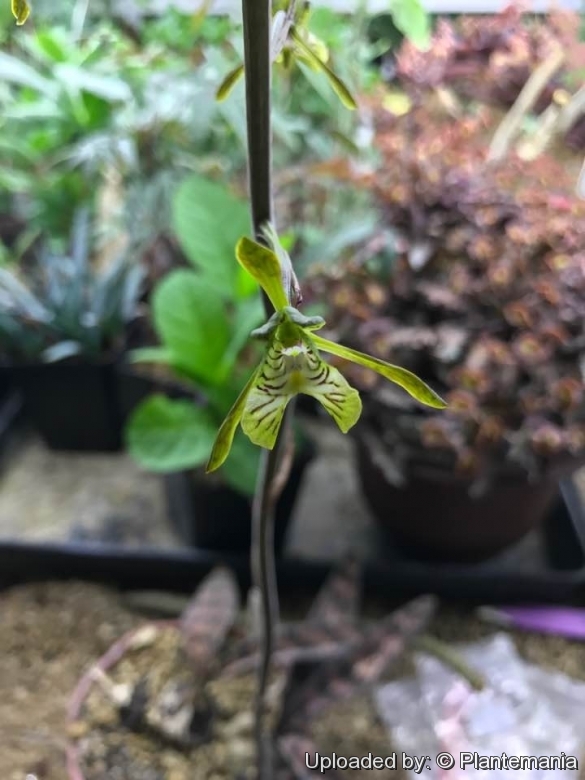





Your support is critical to our success.
Bot. Mus. Leafl. 24: 272 (1976).
Family: ORCHIDACEAE

Origin and Habitat: Oeceoclades spathuliferaSN|34290]]SN|34290]] is is native to a small region of northern and western Madagascar.
Altitude range: 30 to 900 meters above sea level.
Habitat and ecology: This species grows in sandy and porous gravel/soil in forests and on coastal dunes in montane deciduous woodlands. The attractive brown marked camouflage leaves matches that of the surrounding soil and is difficult to spot if not in flower.
Synonyms:
- Oeceoclades spathulifera (H.Perrier) Garay & P.Taylor
- Eulophia spathulifera H.Perrier
- Eulophidium spathuliferum (H.Perrier) Summerh.
- Lissochilus spathulifer (H.Perrier) H.Perrier
Description: Oeceoclades spathulifera is a remarkable xerophytic (dry-habitat) medium sized, warm growing terrestrial orchid with underground preudobulbs carrying 2 to 3 dark green coriaceous leaves attractively patterned with green-blackish markings. Green/red marked flowers are produced on upright stems. O. spathulifera is related to Oeceoclades calcarata and Oeceoclades hebdingiana but it can be distinguished from those species by its long, spathulate (spoon-shaped) sepals and petals and the globose (almost spherical) spur. It seems to be a Madagascan terrestrial succulent.
Pseudobulbs: Small, subterranean, flattened, ovoid and distinctively 4-angled..
Leaves: 2 to 3 leaves top the pseudobulbs and somewhat hug the ground, they are leathery, very thick, elliptic-linear and about 2.5-5 cm wide and 4-10 cm long, long, the surface is hard and shiny as if coated with clear varnish, green to dark green-purple striped with darker pink, green-blackish or tan-pink spots on the top.
Flowers: This species blooms in the late spring and early summer on an erect, basal, simple, several flowered inflorescence. The inflorescences are 15 – 30 cm tall and potentially with 1 or 2 branches. Individual flowers are 5-7.5 cm across. Sepals and petals are green-yellow to olive, and veined darker olive-brown. The labellum is white with red-purple veins.
Hystory: It was first described by the French botanist Joseph Marie Henry Alfred Perrier de la Bâthie in 1935 as Eulophia spathuliferaSN|34291]]SN|34291]]. Perrier later transferred the species to the genus Lissochilus in 1941 and it was again moved to the genus Eulophidium by V.S. Summerhayes in 1957. It was last transferred to the genus Oeceoclades in 1976 by Leslie Andrew Garay and Peter Taylor when they resurrected and revised that genus.
Bibliography: Major references and further lectures
1) Garay, L.A., and P. Taylor. “The genus Oeceoclades Lindl.” Botanical Museum Leaflets, Harvard University 24(9): 249-274 1976.
2) Perrier “Flora of Madagascar” 1983 as Lissochilus spathulifer.
3) Schlechter/Brieger “Die Orchideen lieferung 24” 1991
4) Hermans “Orchids of Madagascar” 2007
5) Cribb & Herman “Field Guide to the Orchids of Madagascar” 2009
6) Roguenant “Mille et Une Mini Orchideees” 2009
7) Wikipedia contributors. "Oeceoclades spathulifera." Wikipedia, The Free Encyclopedia. Wikipedia, The Free Encyclopedia, 11 Feb. 2016. Web. 26 Jul. 2017
8) Oeceoclades spathulifera in: Marlow Orchids, Web. 26 Jul. 2017 http://marlowsorchids.com/inc/sdetail/2739/3991
9) Tulear “Some Unusual Terrestrial Orchids” POLLINIA - January 2012 – pages 3-17, The Irish Orchid Society
Cultivation and Propagation: Oeceoclades spathuliferaSN|34290]]SN|34290]] are relatively easy to grow and like a typical terrestrial mix.
Waterings: Let the soil dry out occasionally.
Exposure. Leaves will show better colouration and markings under bright Cattleya level light, but plants will grow well in lower light levels.
Propagation: While blooming the plants will be quickly pollinate by ants and, and they will go to seed. Seem to be pretty hardy.
| Your Actions | |
|---|---|
| Back to Oeceoclades index | |
| Back to Orchidaceae index | |
| Back to Plant Encyclopedia index | |
Privacy stantement - Terms and conditions - How to cite - About us - Feedback - Donate

